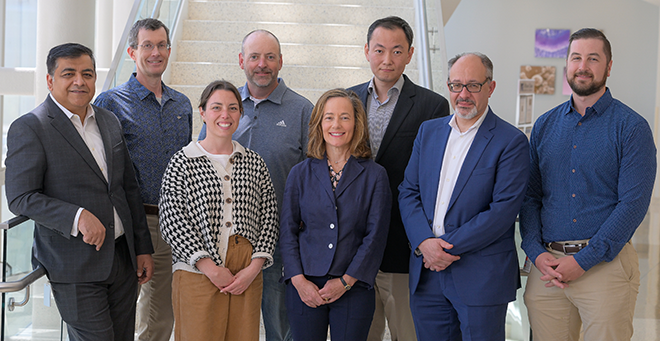
UMass Chan Medical School scientists Marcus Ruscetti, PhD, and Prabhani Atukorale, PhD, have developed a new, dual immunotherapy approach that may potentially change the way clinicians treat pancreatic cancer.
Published in Science Translation Medicine, the strategy combines antagonists that suppress the immune evading ability of tumor cells with the nanoparticle delivery of agonists that wakes the immune system to fight the cancer cell. Animal models treated with the dual therapy approach experienced shrinkage or elimination of pancreatic cancer tumors in eight of nine cases.
“These initial results are very exciting,” said Dr. Ruscetti, assistant professor of molecular, cell & cancer biology. “Pancreatic cancers are challenging to treat, in part because the microenvironment surrounding the tumor is dense and hard to access. This makes drug delivery and immune infiltration difficult. Our dual therapy approach shows promise as a strategy to get to the cancer cells and fight them.”
At a glance |
|---|
|
The study was done in animal models of pancreatic ductal adenocarcinoma (PDAC), the most common form of pancreatic cancer. With a five-year survival rate of only 13 percent, it is the third leading cause of cancer deaths.
Part of the challenge in treating PDAC is the microenvironment surrounding the tumor cells—the complex collection of cells, molecules and blood vessels that surround and support a tumor. This environment can vary between patients, and even within the same cancer type, making it very challenging for scientists to address.
The microenvironment plays a key role in cancer development. It provides nutrients and space for the tumor to grow. In the case of PDAC, the microenvironment is so dense it inhibits the growth of blood vessels that would normally deliver the immune cells necessary to fight the cancer cells and that scientists also use to deliver therapeutic agents.
Using a biocompatible, lipid-based nanomaterial previously developed by Dr. Atukorale, assistant professor of biomedical engineering at UMass Amherst and adjunct assistant professor of molecular, cell & cancer biology at UMass Chan, the researchers were able to encapsulate two molecules that functionally work together but don’t like to sit next to each other that activate the stimulator of interferon genes pathway. This pathway activates the immune system and wakes it up so it can recognize the tumor cells as a threat. Additionally, Atukorale was able to modify the nanomaterials to penetrate the dense tumor microenvironment and reach their intended target.
Together, the research team demonstrated that cancer-suppressing molecules (MEK inhibitor trametinib and CDK4/6 inhibitor palbociclib, or T/P) identified by Ruscetti in previous studies could remodel the microenvironment to allow the immune system to send T cells and enhance the delivery of the nanoparticles containing the immune agonists to the PDAC tumor. Once awakened by the combination therapy, the body’s T cells could begin fighting off the cancer cells.
“The tumor cells have developed a way to evade or shut down the body’s immune system. It’s like a defense mechanism,” said Ruscetti. “They’re shielded. Just getting more T cells into the tumor microenvironment is only the first step. We still have to wake them up. That’s what this second therapeutic does. It allows the immune system to see the cancer cells so they can do their job and get rid of the cancer cells.”
This dual strategy of targeting the tumor microenvironment with immune system activation may also have implications for other cancers such as colon, lung, liver and cholangiocarcinoma (cancer of the bile ducts).
The pair received funding from the BRIDGE Innovation and Business Development at UMass Chan Medical School to continue their work with the goal of attracting potential industry partners and optimizing their nanoparticle approaches for testing in human clinical trials.

